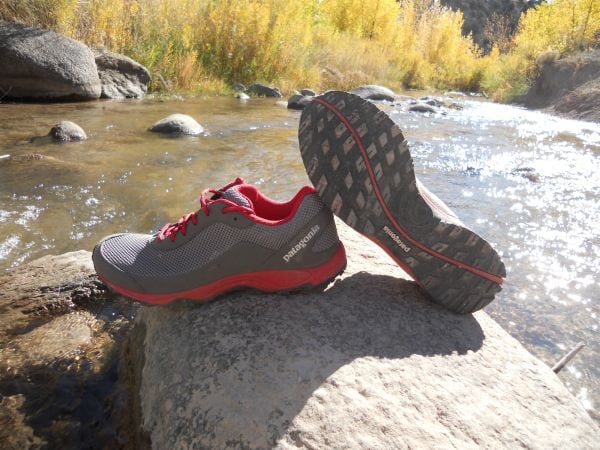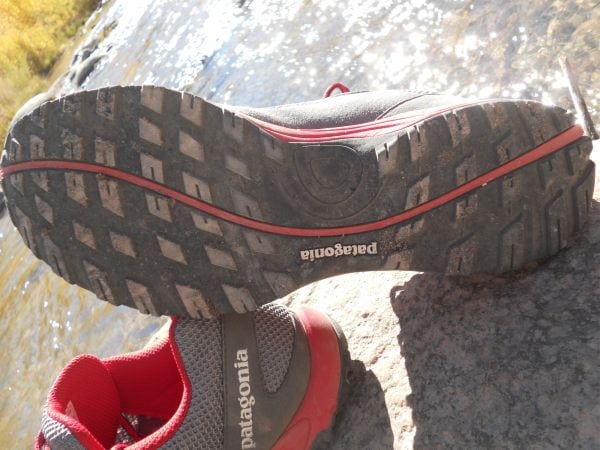Our Favorite Trail Running Shoes
Check out our Best Trail Running Shoes article to learn about our current favorite trail running shoes!
Patagonia Forerunner Review
Simplicity is something that I’ve come to value more and more as I age, and this appreciation extends to gear. Not necessarily absolute minimalism, but nothing wasteful, extraneous, or frivolous. Patagonia may have had this in mind while designing the Forerunner, their newest entry into the trail running market. With a 4 mm heel drop (9mm heel – 5mm forefoot) and weighing in at just over 9 ounces for a men’s 9.5, the Forerunner puts you close to the ground while still giving you responsive cushioning and flexibility to earn the moniker “minimalist.”
[Added: We’ve added a full video review of the Patagonia Forerunner to the bottom of this article.]
First Impressions
I’ll admit that Patagonia trail running shoes I’d seen and tried on in the past looked like nothing more than light hikers with seemingly little design given to trail running. The Forerunner even looks more like a shoe you’d see on a coffee shop patron rather than a fully realized trail shoe, but that is where the similarities to Patagonia’s previous trail models end. The Forerunner fit my foot like a glove right out of the box and the 9 ounces of shoe were barely noticed during my first run on technical trail.
Upper
The Forerunner features a durable mesh upper surrounded by a breathable synthetic leather around the base and toe of the shoe. A well-cushioned, but not overly beefy, tongue provides enough protection for a traditional lacing system with fairly standard sized oval laces. The Forerunner does not have any overlays in the upper to provide added support, but the fit is fantastic with plenty of lockdown. The heel collar is well padded and the heel cup is fairly pliable. A synthetic leather overlay wraps around the back of the heel and the Forerunner does not have any toe bumper to speak of. To be honest, this has to be the simplest upper of a trail shoe that I’ve ever reviewed.
Midsole
Due to the low heel drop the Forerunner gives a very low to the ground, proprioceptive feel. The midsole cushioning is simple EVA foam (as best as I can tell) which feels firm and responsive all at the same time. The Forerunner is quite flexible and forefoot and mid foot strikers will love the fact that the cushioning stays fairly uniform the length of the shoe. The Forerunner does not seem to have any sort of a rock plate, but I didn’t want for more protection, even on sharp rocks. A tad bit of medial support is available due to the outsole of the shoe curling up to create a minimal arch in the shoe, and I did not feel any other motion control devices in the midsole.
Outsole
A simple, yet effective, lug pattern runs throughout the flexible outsole of the Forerunner. This rubber feels very tacky, and I felt like the Forerunner has better than average grip compared to most trail shoes. It shed mud and clay quickly during wet runs due to the lugs not being too large or deep. On rocks the flexibility of the Forerunner allowed it to grab really well and I really had zero traction issues with this shoe.
Overall Impression
Patagonia markets this shoe as their entry into the minimal trail shoe world, and some may balk at the weight (over 9 oz for men) citing it as a disqualification from this category. However, minimalism also implies simplicity and this may be the simplest trail shoe I’ve ever tested. No new technologies, no gimmicks, no fancy names for features that don’t function. Just a simple trail shoe with an uncomplicated upper, an efficient flexible midsole, and a sticky rubber outsole. In fact, I couldn’t even find anything I didn’t like about this shoe.
But, the real test of course comes during the long run and whether this shoe could be worn for an ultra. To those biomechanically gifted runners who can manage the post-marathon distance in something like the New Balance MT101 or a pair of road racing flats the Forerunner will provide more than enough protection. For others who value the feel of a minimalist trail shoe but tend to wear something more substantial for ultras, the Forerunner is a great shoe up to 50k. It will be available for $110 in early 2012.
What do you think of Patagonia Footwear’s venture into the lightweight trail runner market? If you’ve gotten a sneak peak, what did you think?
What is your ideal concept of minimalism? Does it focus on low weight? Low heel-to-toe drop? Low overall height? Simple construction? Something else entirely?



